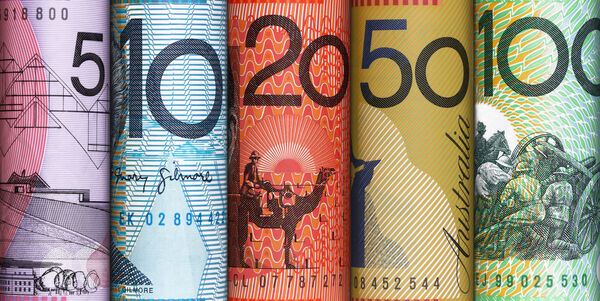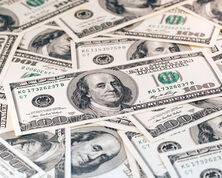
Australia's banknotes are much more than mere currency. They serve as vivid canvases of the nation's rich history and diverse culture. Each denomination tells a story featuring iconic individuals whose lives have left an indelible mark on the Australian landscape. As we embark on this exploration, we delve into the historical and cultural context that breathes life into the portraits adorning the Australian Dollar notes.
This is the first part of a blog series exploring the faces that adorn banknotes.
The roots of Australia's currency system are intertwined with its colonial past, echoing a narrative that evolves from the resilience of early settlers to the vibrant multiculturalism of the present. The choice of personalities on the banknotes reflects their individual achievements and roles in shaping Australia's identity. From the sovereign grace of Queen Elizabeth II to the pioneering spirit of Mary Reibey, the currency becomes a visual anthology of the nation's journey.

These banknotes are testaments to cultural milestones, honouring figures who've excelled in literature, music, business, and Indigenous advocacy. As we traverse through denominations, we will uncover the historical context behind each choice, delve into the cultural significance of the featured individuals, and appreciate the meticulous design elements that make these banknotes not only legal tender but also captivating windows into Australia's past and present. Join us on this enlightening expedition into the heart of Australia's monetary heritage.
Before Federation, the six colonies that made up Australia had different currencies which were all exchangeable with one another. It wasn't until 1910 that the Australian Pound (A£) was introduced, pegged to the Pound Sterling. In 1959, a committee began examining the benefits of decimalisation, and eventually put forward the proposal of a new currency; the Australian Dollar. It was introduced in 1966.
Australia was the first country in the world to introduce polymer notes in 1988. Polymer notes are cleaner than paper notes, more durable and easily recyclable. They are now used in more than 45 countries worldwide.
AU$5 Note - Queen Elizabeth II
Queen Elizabeth II, Australia's constitutional monarch, features on the AU$5 note as a tribute to her role in shaping the nation's constitutional framework. Her reign represented stability and continuity, reflecting Australia's historical ties to the British monarchy. Following the death of Queen Elizabeth II, the Reserve Bank of Australia announced that a design celebrating First Nations peoples would appear on the new note instead of a portrait of King Charles III.
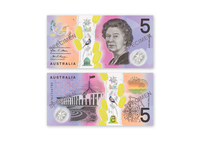
Symbolising the Commonwealth, Queen Elizabeth II's portrait stands as a testament to the enduring connection between Australia and its part in the Commonwealth. The inclusion of her image underscores the nation's commitment to shared values and governance.
A gradient of purple, pink and orange sweeps across the note, with elements from the country's natural world, including a depiction of the Eastern Spinebill, a native bird, and the Prickly Moses wattle, a native plant, adding a touch of indigenous flora to the overall aesthetic. The reserve features Parliament House in Canberra, showing an architectural plan of the building and the mosaic forecourt, named Possum and Wallaby Dreaming, by Aboriginal artist Kumantje Jagamara.
AU$10 - Banjo Paterson & Dame Mary Gilmore
Andrew Barton (Banjo) Paterson, celebrated bush poet, graces the AU$10 note, paying homage to his literary contributions. Paterson's iconic works, such as "Waltzing Matilda" and "The Man from Snowy River," capture the essence of Australian outback life, immortalising him as a cultural icon.
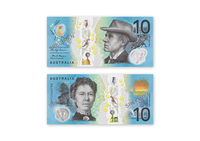
As a cultural figure, Banjo Paterson's poetry has become synonymous with Australian identity. His verses resonate with readers worldwide, showcasing the unique spirit of the Australian landscape and its people.
The design features a thoughtful blend of Paterson's portrait, with scenes from his poems including a horse from the Snowy Mountains region and a wattle plant. Turn over and you find a portrait of Dame Mary Gilmore, a writer and journalist known for her prolific contributions to Australian literature. This harmonious composition creates a visually engaging banknote that encapsulates the essence of Australian literature.
AU$20 Note - Mary Reibey & Rev John Flynn
Mary Reibey, a pioneering businesswoman and convict turned entrepreneur, adorns the AU$20 note. Her inclusion reflects the resilience and tenacity of early Australian settlers, particularly women, in overcoming adversity and contributing to the nation's development.
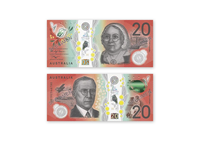
Reibey's cultural significance lies in her journey from convict transportation to becoming a successful trader and businesswoman. Her story symbolises the spirit of determination and enterprise that helped shape Australia's economic landscape.
The design incorporates representations of Reibey's life, including an image of her convict ship. On the other side is Rev John Flynn, founder of Frontier services, an organisation that continues to support those living in isolated areas of Australia, along with a Royal Flying Doctor Service de Havilland plane.
AU$50 Note - David Unaipon & Edith Cowan
David Unaipon, an Indigenous Australian inventor, writer, and preacher, graces the AU$50 note. Known as the "Australian Leonardo," Unaipon's inclusion celebrates his pioneering work in inventions and his efforts to bridge cultural understanding between Indigenous and non-Indigenous communities.
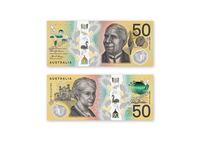
Unaipon's cultural significance lies in his role as a trailblazer, breaking barriers for Indigenous Australians in science, literature, and social advocacy. His achievements contribute to fostering appreciation for Indigenous contributions to Australian society.
His portrait is complemented by representations of his mechanical innovations against a yellow, red and green sweeping gradient, creating a visually compelling narrative. On the reverse is a portrait of Edith Cowan, the first female member of Australian Parliament, along with Western Australia's original Parliament House, and a note that reads "As a full-blooded member of my race I think I may claim to be the first - but I hope, not the last - to produce an enduring record of our customs, beliefs and imaginings".
AU$100 Note - Dame Nellie Melba & Sir John Monash
Dame Nellie Melba, an internationally acclaimed opera soprano, graces the AU$100 note. Her presence commemorates her exceptional musical talent and contribution to the arts, elevating Australia's cultural reputation on the global stage.
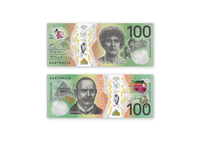
Melba's cultural significance lies in her unparalleled success as a renowned opera singer, earning her acclaim worldwide. Her legacy endures as a symbol of Australia's cultural prowess and the capacity of its artists to achieve global recognition.
The design reflects Melba's musical legacy, incorporating a range of motifs, including an image of a lyrebird representing Australia's unique wildlife and an operatic excerpt from one of Melba's famous performances. Turn over and you'll find a portrait of First World War general Sir John Monash with an image of the Shrine of Remembrance in Melbourne with poppies in the foreground. Monash is commemorated throughout Australia with many public facilities bearing his name.

Ben Tully
Visual Design & Content Creation
Ben deals with all things design, working on the visual design of our annual guides, Destinations magazine, information leaflets, social media and email campaigns, and much more across the Alan Rogers, Rallies and Worldwide brands. He also produces written content for our blogs alongside our other contributors.
More by Ben TullyRecent Blog Posts
-
Explore the World Your Way
February 13, 2025 -
Guest Post: A Journey through the Parks and Lakes of Western Canada
October 28, 2024 -
Rhythms of the South: Celebrating the Sounds of Southern Soul, Gospel and Funk
October 10, 2024 -
Rhythms of the South: Exploring the Soul of Memphis Blues, Soul and Rock 'n' Roll
October 2, 2024 -
Rhythms of the South: A Journey Through the Jazz and Dixieland Roots of New Orleans
September 24, 2024
